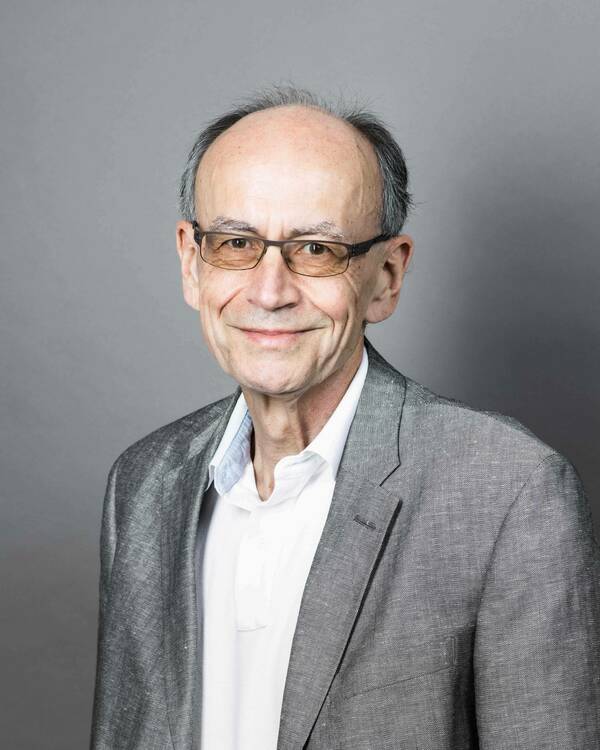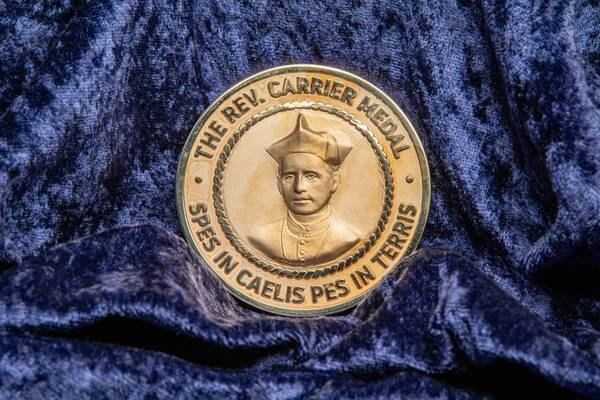
Dr. Thomas Südhof, one of the recipients for the 2013 Nobel Prize in Physiology or Medicine, could have launched his career in multiple directions.
Growing up in Germany in a family deeply entrenched in the Waldorf educational principles of experiential learning, Südhof, the recipient of the 2023 Rev. Joseph Carrier C.S.C. Science Medal from the University of Notre Dame College of Science, considered music (he formerly played the bassoon), philosophy, or history as more interesting prospects than medicine when he headed to college. In the end, he decided to follow in the footsteps of his parents, who were both physicians, but eventually made the switch to the laboratory. Südhof is currently Stanford University’s Avram Goldstein Professor Investigator, Howard Hughes Medical Institute, and serves as professor in the Department of Molecular & Cellular Physiology and of Neurosurgery as well as in the Department of Neurology & Neurological Sciences and of Psychiatry & Behavioral Science.
He will accept the Rev. Carrier Medal at 5 p.m. on Monday, Oct. 23 in the Dahnke Ballroom, on the seventh floor of the Duncan Student Center at Notre Dame Stadium. His lecture, “Toward a Cell Biology of Alzheimer’s Disease,” will describe his laboratory’s recent studies that illustrate how investigations into the cell biology of neurons and glia have the potential to provide insight into the molecular mechanisms of Alzheimer’s disease, and might lead to better therapies.
He had already attended medical school at the University of Göttingen in Germany before he realized that it might not be the right career for him. As someone who values listening to his inner voice above trends and in tandem with solid advice from mentors, he understood that he could help patients more as a scientist than as a doctor, and forged a path to the laboratory.
“When I was in medical school, it was a different time than nowadays when it is very structured, and people don’t have any freedom to do science because they don’t have time—they’re trained as medical super technicians more than as scientists,” he said. After completing his medical training, he decided to join the laboratory of the professionally inseparable duo of Michael S. Brown and Joseph L. Goldstein at the University of Texas Southwestern Medical School in Dallas.
While in their lab, Südhof focused on studying cholesterol. He cloned the gene encoding the receptor that binds to particles called low-density lipoproteins (LDLs), which are the primary carriers of cholesterol in the blood. Brown and Goldstein were awarded the Nobel Prize in Physiology or Medicine in 1985.

“I was extremely happy they got the award,” he said, when asked if their success inspired his own. “But there’s no question that this isn’t the reason to go into science—I didn’t go into science to win awards. That was not on my agenda, or thoughts, or whatever else.”
When it was time for him to go back to Germany to complete his medical training, Brown and Goldstein encouraged Südhof to change his mind and continue in laboratory science instead. He began his work on overarching neuroscience questions, switching away from the study of cholesterol.
“Brown and Goldstein had done such a great job with their research, figuring out how cholesterol is synthesized, and had performed tremendous work, translating that into human therapies that have changed lives,” he said. “There really was nothing I could add to that.”
His 2013 Nobel Prize was awarded for his work from the 1990s in which he studied sac-like structures, called vesicles, that transport substances to different places inside the cell and then send molecules from the cell’s surface as signals to other cells in the body. By studying brain cells from mice, he showed how vesicles are held in place, ready to release signal-bearing molecules at the right moment, according to the Nobel Prize website. He shared the prize that year with James E. Rothman and Randy W. Schekman.
Südhof’s broad research question now is to discover how synapses—the points between neurons and the parts in which neurons form contacts that permit and process information—are formed. He’s also researching how neurons “know” which other neurons to form synapses with for a healthy brain. What happens with neurons in diseases like Alzheimer’s disease? Synapses are the fundamental computational unit of the brain, and may hold the key, he described.
“What’s the benefit of being able to live longer because we are able to treat other diseases, while your brain goes basically kaput?” he asked. “If your brain is diseased, then you can’t use all the benefits of our enhanced survival.
“There has been very little funding for the brain; it’s an area that’s coming to the fore now more and more because people realize that it’s great to be able to live beyond the age of 90, but if your chance of getting Alzheimer’s disease is 50% beyond the age of 90, we need to learn how to deal with it.”
In a time when increased pressure and importance is placed on publishing a discovery in a high-impact scientific journal and collaborating with others with whom the scientist has little connection, Südhof suggests that it’s more important to have good teachers, excellent mentors and a scientifically stimulating environment to succeed as a scientist.
“The place one publishes isn’t ultimately important. Rather focus on the content of the study, what the data really says (not just the abstract). Then we can take pride and pleasure in work that reports and advances discoveries,” he wrote as part of his Nobel Prize acceptance.
The October 23 event is free and open to the public. The inaugural Rev. Carrier Medal and Lecture was first awarded in 2022 to Donna Strickland, a 2018 winner of the Nobel Prize in Physics and a professor at the University of Waterloo in Waterloo, Ontario, Canada.